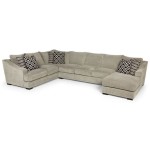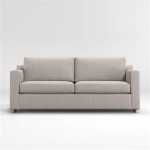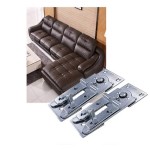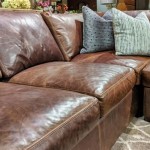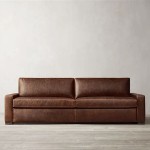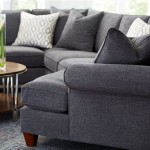Finding Affordable Comfort: Sectional Sofas Under $300
For individuals seeking to furnish their living spaces without exceeding a strict budget, the prospect of acquiring a sectional sofa might initially seem unrealistic. Sectional sofas are often perceived as substantial investments, potentially placing them outside the financial reach of many. However, the reality is that a range of sectional sofas are available for under $300, offering a viable option for budget-conscious consumers. Understanding the nuances of this price point and the associated trade-offs is crucial for making informed purchasing decisions.
Acquiring a sectional sofa within this price range typically necessitates a shift in expectations regarding materials, size, and overall quality compared to higher-priced models. Manufacturers often employ cost-effective production methods and materials to achieve this affordability. This can involve using different types of fabric, simplified frame construction, and a reduction in the density of the cushioning. Despite these considerations, these sofas can still provide a comfortable seating solution and contribute to the aesthetic appeal of a room.
The primary focus when considering sectionals under $300 should be on identifying those options that offer the best balance of durability, comfort, and style within the available price constraints. Careful evaluation of the product specifications, customer reviews, and warranty information is essential for ensuring satisfaction and minimizing the risk of premature wear and tear.
Understanding the Trade-offs: Material and Construction
One of the most significant factors contributing to the affordability of sectional sofas in this price range is the materials used in their construction. The fabrics are often synthetic, such as polyester or microfiber, chosen for their lower cost and relative durability. While these materials may not possess the luxurious feel of higher-end fabrics like leather or linen, they can still provide a reasonable level of comfort and resistance to everyday wear and tear.
The frame construction is another area where cost-saving measures are implemented. Instead of solid hardwood, which is typically found in more expensive sofas, the frames may be constructed from engineered wood products, such as plywood or particleboard. While these materials are less durable than hardwood, they can provide adequate support for everyday use, provided the sofa is not subjected to excessive weight or rough handling.
The cushioning is another critical component that impacts both comfort and cost. Sofas in this price range often utilize foam cushioning with lower densities. This can result in the cushions feeling less plush and potentially compressing more quickly over time. However, some manufacturers may incorporate features like pocket coils or fiberfill to enhance comfort and resilience within the budget constraints. Consumers should pay close attention to the cushion composition and support system when evaluating different models.
Careful consideration should be given to the longevity of the sectional. The inherent trade-offs in materials and construction mean that a sofa in this price range may not last as long as a more expensive option. However, with proper care and maintenance, it can still provide several years of comfortable use. Regular cleaning, avoiding excessive weight, and protecting the sofa from direct sunlight can help extend its lifespan.
Assessing Size and Configuration Options
The size and configuration options available for sectional sofas under $300 will likely be more limited compared to higher-priced models. Smaller sectional configurations, such as loveseat sectionals or those with only a few modular pieces, are more common within this price range. This is due to the lower material costs associated with smaller dimensions.
Consumers should carefully measure their available space and consider the overall layout of their room before selecting a sectional. Compact sectional configurations can be ideal for smaller apartments or living rooms where space is limited. Corner sectionals, which maximize seating capacity in a limited area, can also be a suitable option. The adaptability of modular sectional sofas offers flexibility as they can be arranged to fit different room sizes.
The seating depth and height should also be considered. A deeper seat can provide a more relaxed lounging experience, while a higher seat can be more comfortable for individuals with mobility issues. Consumers should ideally test the sofa in person, if possible, to ensure that the dimensions are suitable for their needs and preferences. Pay attention to the armrest height and the overall aesthetic of the sectional to confirm it fits with the decor of the room.
The configuration options may be limited to left-facing or right-facing chaise lounge sections, as fully modular designs with multiple components tend to increase the overall cost. However, some manufacturers may offer reversible chaise options, providing greater flexibility in terms of room layout. Checking the dimensions of each component section is critical to ensure the whole unit will fit appropriately in the intended space.
Evaluating Comfort and Style Considerations
While affordability is the primary focus, comfort and style should not be completely disregarded when choosing a sectional sofa under $300. Although the materials and construction may be more basic, the overall comfort and aesthetic appeal can still significantly impact the enjoyment of the sofa.
Consider the style of the room. A modern room might require a different style sofa than a more traditional space. Look at the shape of the sectional, the color of the fabric, and the detailing on the arms and legs. Neutral colors are often a safe choice, as they can easily blend with a variety of décor styles. In addition, darker colors tend to hide wear and tear better than lighter colors.
The comfort of the sofa is a combination of factors, including the seat depth, the firmness of the cushions, and the upholstery fabric. While it may not be possible to find a sectional with the same level of plush comfort as a higher-end model, consumers can still look for options that provide adequate support and cushioning.
Pay attention to the details, such as the stitching and the overall finish of the sofa. While minor imperfections may be expected at this price point, the overall craftsmanship should be of a reasonable standard. Check for loose threads, uneven seams, or any other obvious defects that could indicate poor quality. Review customer feedback on comfort and style for more insights.
Ultimately, selecting a sectional sofa under $300 involves balancing affordability with acceptable levels of comfort, durability, and style. By carefully considering the trade-offs involved and focusing on key product specifications, consumers can find a viable seating solution that meets their needs without exceeding their budget. Examining the manufacturer's reputation can be helpful to ensure ethical production practices. Thorough planning and research are essential for making an informed decision that provides satisfaction in the long term.

12 Best Couches Under 300 In 2024 Our Top Picks

Affordable Sectionals Under 300 For Small Spaces Sden

Best Couches Under 300 2024 Sofas

Linsy Home Modular Couches And Sofas Sectional With Storage Sofa L Shaped Couch Reversible Chaises Light Gray Com

10 Best Apartment Sized Sofas For Every Style 2024

Linsy Home Modular Couches And Sofas Sectional With Storage Sofa L Shaped Couch Reversible Chaises Light Gray Com

13 Best Sofas Under 300 That Don T Look

Sectional Sofas Modular Sectionals Target

10 Best Sectional Sofas Of 2024 What Brands Them Home Cozy

Linsy Home Modular Couches And Sofas Sectional With Storage Sofa L Shaped Couch Reversible Chaises Dark Gray Com

